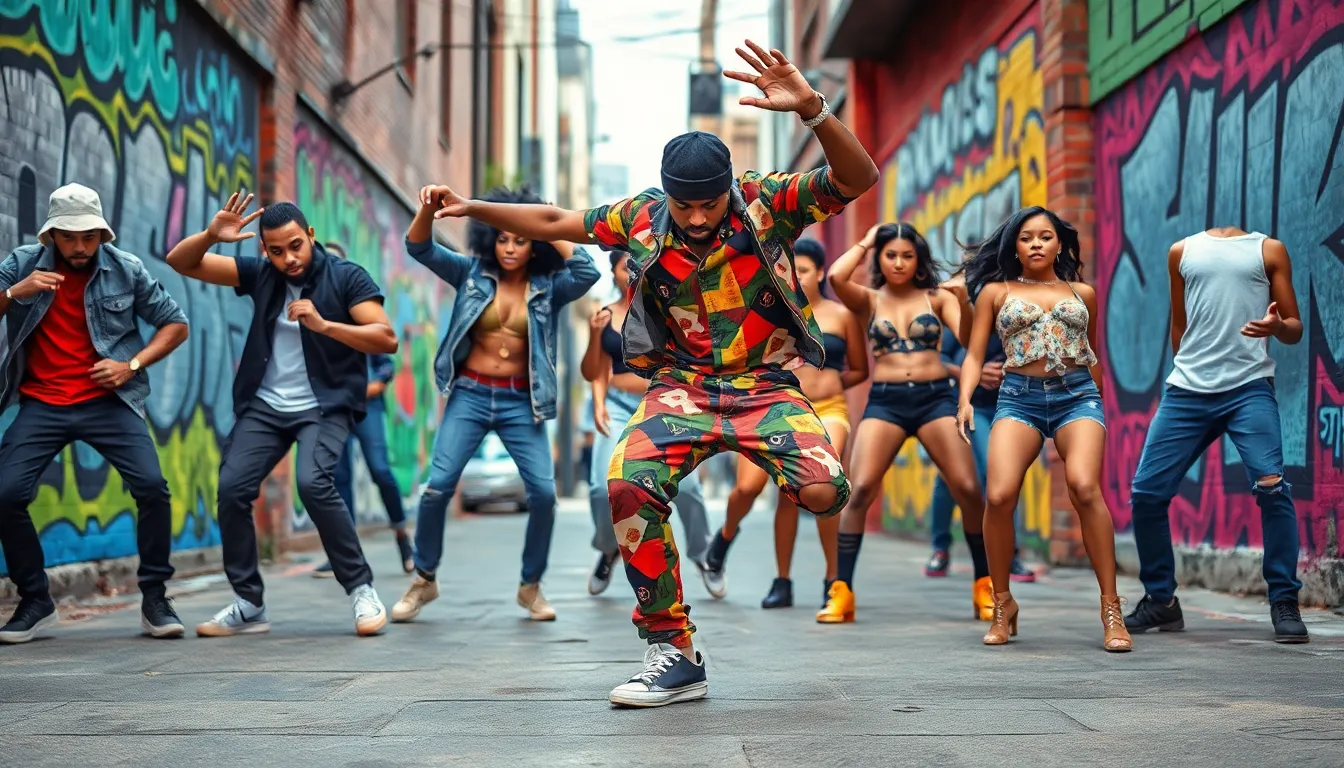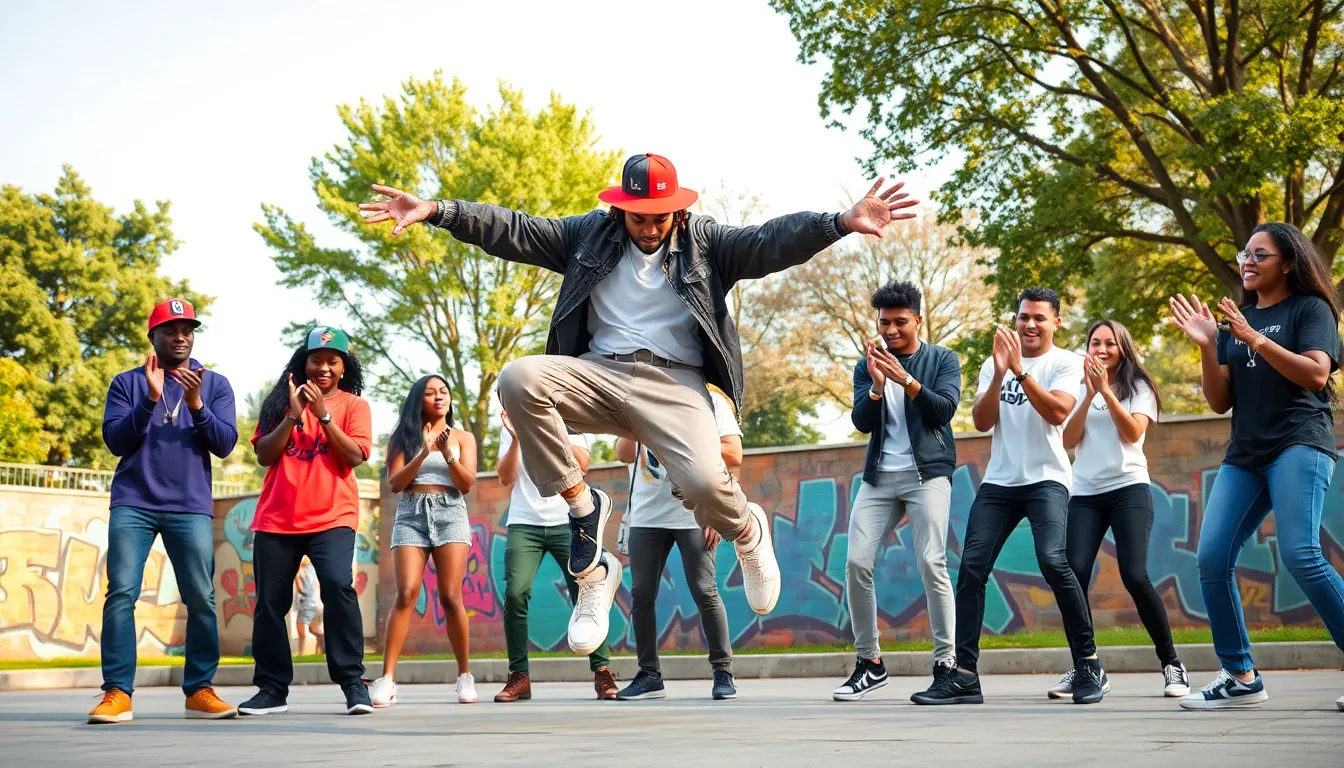Hip-hop dancing isn’t just a way to bust a move; it’s a vibrant culture that’s taken the world by storm. Picture this: a group of dancers, each with their unique style, seamlessly blending rhythm and creativity. From breakdancing to locking and popping, hip-hop offers a thrilling escape from the ordinary. It’s the dance that makes you feel alive, even if your two left feet say otherwise.
Table of Contents
ToggleOverview of Hip-Hop Dancing
Hip-hop dancing embodies a vibrant cultural expression that draws from various influences. Breakdancing, locking, and popping represent some prominent styles within this genre. Each style showcases distinct movements and techniques, contributing to the overall dynamic nature of hip-hop.
Originating in the late 20th century, hip-hop dancing evolved alongside hip-hop music. Neighborhood block parties often served as the stage for these energetic performances. These gatherings allowed dancers to express themselves creatively and competitively, fostering a sense of community.
Performance aspects include not just technical skill but also personal style. Dancers infuse their unique gestures and rhythms into routines, making every performance distinctive. The improvisational nature encourages self-expression, resulting in thrilling and unpredictable displays.
Training in hip-hop dancing varies widely. Classes can range from professional studios to community centers. Some dancers learn through informal gatherings, sharing techniques and styles with peers in a fun environment.
Events such as dance battles and showcases highlight the competitive spirit of hip-hop culture. Dancers compete for recognition and respect, pushing each other to elevate their skills. Such events foster connections within the hip-hop community while driving the evolution of dance styles.
Cultural impact extends beyond dance, influencing fashion, language, and social movements. Hip-hop dancing remains a powerful vehicle for cultural storytelling and artistic expression. It’s essential to recognize the role of hip-hop as a significant cultural phenomenon thriving in today’s diverse society.
History of Hip-Hop Dancing

Hip-hop dancing emerged as a vibrant form of expression linked closely with hip-hop music in the late 20th century. This dance form thrives on creativity and community engagement.
Origins and Influences
Origins trace back to the early 1970s in the South Bronx, fueled by African American, Latinx, and Caribbean cultures. Influential figures included DJ Kool Herc, who introduced breakbeats, influencing dancers to create new moves. Additionally, the influence of funk music introduced styles like locking and popping, enriching the emerging hip-hop dance scene. Street corners, block parties, and underground clubs served as essential venues, allowing dancers to showcase their skills and connect with their local communities.
Evolution Through the Decades
Throughout the 1980s, hip-hop dance gained national attention with the rise of breakdancing. This energetic style captivated audiences, leading to television appearances and film features. By the 1990s, various styles integrated into hip-hop culture, reflecting societal changes and artist expressions. The advent of music videos showcased dancers internationally, solidifying hip-hop as a global phenomenon. In the 2000s and beyond, hip-hop dance increasingly incorporated elements from contemporary styles, allowing for greater fusion and innovation. Today, countless competitions and classes continue to foster talent and further the evolution of this dynamic art form.
Key Elements of Hip-Hop Dancing
Hip-hop dancing encompasses various styles and techniques that enhance its vibrant culture. Each style contributes unique movements and expressions, shaping the overall experience.
Styles and Techniques
Breakdancing showcases dynamic spins and acrobatic movements that captivate audiences. Locking features distinct pauses and fluid transitions, creating a playful rhythm. Popping relies on sharp, jerky muscle contractions, resulting in impactful visuals. Krumping expresses raw emotion through exaggerated and energetic movements. Each technique serves as a foundation, allowing dancers to blend styles into their own routines.
Importance of Improvisation
Improvisation plays a critical role in hip-hop dancing, fostering creativity and expression. Dancers often incorporate spontaneous movements that reflect their emotions and energy. This spontaneity encourages individual style, making each performance unique. Connecting with the music enhances the improvisation process, allowing dancers to react instinctively to rhythm changes. As a result, scenes at dance battles and showcases can become thrilling showcases of bold creativity.
Popularity and Cultural Impact
Hip-hop dancing thrives in various aspects of popular culture, influencing and shaping trends across generations.
Hip-Hop Dancing in Mainstream Media
Mainstream media showcases hip-hop dancing through music videos, movies, and television shows. Reality competitions like “So You Think You Can Dance” highlight talented dancers, elevating their visibility. Films such as “Flashdance” and “Step Up” feature hip-hop dance prominently, attracting diverse audiences. In recent years, social media platforms like TikTok enable dancers to share their moves, fostering viral trends and reaching global audiences. These platforms cultivate a vibrant community, allowing participants to engage and inspire one another through dance. As a result, hip-hop dance continues to gain prominence, attracting new fans and influencing countless creative projects.
Community and Social Aspects
Community plays a vital role in hip-hop dancing, providing a sense of belonging and culture. Local events and gatherings encourage dancers of all levels to connect, learn, and share their passion. Dance battles foster friendly competition, showcasing talent while nurturing camaraderie within the community. Participants often cultivate friendships through shared experiences and collaboration. Various dance studios and community centers offer classes designed to enhance skills and promote inclusivity. Social movements also utilize hip-hop dance as a form of protest, addressing important societal issues. Through these connections, hip-hop dancers build a supportive network that celebrates creativity and individual expression.
Hip-hop dancing embodies a vibrant cultural expression that continues to evolve and inspire. Its rich history and diverse styles create a unique platform for creativity and self-expression. The community aspect fosters connections among dancers while encouraging personal growth and innovation.
As hip-hop dance gains global recognition through various media, it remains a powerful tool for storytelling and social commentary. Whether in a dance battle or a casual gathering, the essence of hip-hop dancing lies in its ability to unite individuals and celebrate their individuality. Embracing this dynamic art form can lead to exhilarating experiences that resonate far beyond the dance floor.



